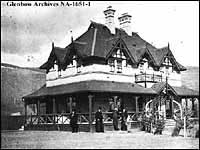Ce texte a été publié en anglais et n'est pas disponible en français.
"Meanwhile, back at the ranch..."
by Dorothy Field
For most of us, "ranch house" conjures up scenes from television classics like Gunsmoke, Rawhide, and Bonanza. Or, it brings to mind "Ranch Style" homes from suburbs developed in the 1950s and 1960s.
When it comes to forming an accurate picture of authentic early Alberta ranch houses, these stereotypical, familiar images don't help much. To be sure, some were rambling single storey buildings and some had a porch that could be used as a hitching post, but that certainly doesn't describe them all. Alberta's ranch houses were as diverse as the people who built them.

Ranching continues today as a major economic force in Alberta, but many consider it "Golden Age" to have occurred long ago, before the disastrously severe winter of 1906-07. Those were the days when sprawling grazing leases still included the best grasslands, uncluttered by fences of "nesters" (farmers). The two ranch houses I describe in this article are from this period. At the high end of the scale is the striking house on the Bow Valley Ranche on Fish Creek, near Calgary. It was designed by architect James Llewellyn Wilson and constructed in 1896 for William Roper Hull, one of Calgary's most successful early entrepreneurs. His fortune came from ranching, meat packing, farming, land speculating, and urban development. Hull was of the "Big Four" cattlemen who launched the Calgary Stampede in 1912.
Appearances were important at the Bow Valley Ranche. Prestige value was added to the house's ordinary wood frame construction be a veneer of yellow bricks accented with red bricks. These may have been manufactured in Calgary (the first brickyard opened in 1886) or brought from farther afield. Either way it would have been a costly upgrade and must have been an important aspect of the design for Hull.
Comfort was also a priority in the design of this ranch house. It would have been warm and cozy in winter - compound chimneys indicate numerous fireplaces. In summer, the wide verandah provided welcome shelter from the sun. Large windows let in ample light and framed many views of the foothills. In its context, the Bow Valley Ranche house, though no palace was the acme of luxury and ostentation. Indeed, it was the scene of lavish social gatherings for Calgary's high flyers, provided accommodation for visiting dignitaries, as was widely admired as a fine example of its type.

The Mexico Ranch house, built in 1902, provides a glimpse of the other end of the spectrum. Pretentiousness and ease clearly did not loom large in the plans for this dwelling, located in the arid badlands along the Red Deer River. No architect was involved. Constructions materials were salvaged from along the river and hewn by hand. The logs have dovetail corners and were chinked with mud; the roof made of split pine poles with sod over top. A small glass-paned window in each of the building's two rooms is the only nod to modern convenience. Surprisingly, the house has a basement but no foundation. These quarters were apparently snug and warm in winter but leaked during the infrequent rains.
The ranch belonged to Delaval James De La Poer Beresford, the younger son of a prominent family. Known (inaccurately) as Lord Beresford in North America, he had left England in the late 1800s to pursue his fortune in the New World. Like many "remittance men," he was ill-equipped for this endeavour and depended to some extent on money from home (remittances). His adventures began in Mexico, where he took up ranching. Over time, he acquired additional holdings in New Mexico and finally came to Alberta in search of grazing for his cattle. By the time of his death in a North Dakota train wreck in 1906, Beresford was enjoying some success - largely due to the partnership he developed in Mexico years before with a black woman known as Lady Flo, who had better business sense than he.

Unconventional by all accounts, Beresford was attracted to the rough-and-ready men who were the mainstay of the cattle ranching business - cowboys. One such man became foreman of the Mexico Ranch in 1903 and stayed on until his death in 1942. In all those years Hansel "Happy Jack" Jackson made few changes to the buildings. He always hauled his water from the Red Deer River, a quarter mile away, and had a privy some distance away amongst the sagebrush.
If Alberta's ranch houses have something in common, it is that they each have a story to tell. They variety of building materials, styles, ornamentations, and construction techniques both reflect and enrich the stories of the people who made them.
Dorothy Field, MSc., is Head of the Heritage Inventory Program at Alberta Community Development, Historic Sites Services. She received her master's Degree in Architectural History in 1986 from the Bartlett School of Architecture and Planning, University College, London, England.
Reprinted with the permission of Dorothy Field and Legacy, Alberta's Cultural Heritage Magazine





